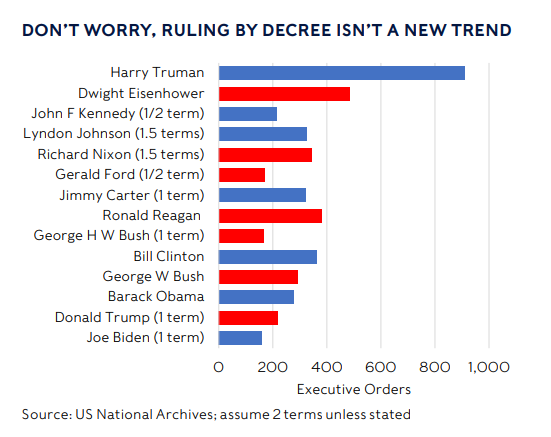
Inauguration day
GOVERNMENT BOND YIELDS FELL BACK ON BETTER-THAN-FORECAST INFLATION AS DONALD TRUMP’S FIRST DAY IN OFFICE NEARED. THE BIG UNKNOWN FOR INVESTORS IS WHICH TARIFF POLICY – WE’VE HEARD MANY VERSIONS – THE NEW ADMINISTRATION WILL LAND ON.
Donald Trump will be sworn in as the 47th US President in an indoor ceremony at the Capitol today, as an Arctic wind brings the coldest Inauguration Day since 1985.
While snow isn’t forecast, a blizzard of executive orders is: Trump has said he intends to sign close to 100 of them on his first day in office. Outgoing President Joe Biden spent the past few days issuing decrees of his own, including a ban on new offshore drilling in certain waters, an order for energy and defence land to be leased to AI data centres and new measures to combat cyber-crime. Trump’s executive orders are expected to cover immigration, energy and government hiring policies among other things. Others will likely reverse many of the executive orders issued by Biden throughout his presidency.
As the president is the leader of the executive branch of the US government, executive orders are really just directives used to manage the operation of the federal government. They don’t have to go through Congress (the normal legislative process) because the executive branch is the sole remit of the president. Executive orders are typically based on existing statutory powers and laws; however, sometimes the line between executive actions and lawmaking can become blurred. That can cause some accusations of presidents circumventing Congress.
Despite what some commentators say, that’s not a new phenomenon. You can see from the chart that the number of executive orders hasn’t increased over time and isn’t favoured particularly by any one party. Democrat Harry Truman issued the most in our chart with 908. But we left out his predecessor, Franklin Roosevelt, because he skewed the chart so much! Roosevelt issued more than 2,000 over his three terms (he died a couple of months into his fourth term). He and Truman could be outliers because they led the country through the only total war in the nation’s modern history. But since then, no one else has issued anywhere near as many.

It’s unclear whether trade tariffs will be among the first flurry of Trump’s executive orders. His protectionist policy was consistent throughout his campaign, even if the details changed often. At different times he has threatened to impose tariffs of varying amounts, sometimes up to 100% of an import’s value, on virtually every American trade partner of note: China, Europe, Canada, Mexico, Brazil, India, South Africa and the UAE. At one point he suggested a universal tariff on all imports, regardless of where they came from. Then, only days before his inauguration, the Wall Street Journal was briefed that Trump wants to visit China to smooth the relationship between the two countries. Investors will have to wait and see what path Trump actually takes on trade.
After an initial post-election surge, markets became wobblier in recent months. Bond yields, which determine the cost of borrowing for everyone from the government to households, took a noticeable step higher (because their prices fell) and the US stock market went sideways. Other advanced nations’ stock markets did better, no doubt helped by their currencies weakening against a supremely strong dollar. Last week was more helpful for government bonds though, with 10-year yields falling back: the US dropped 0.2% from its recent peak to 4.61%, the UK fell slightly more from a higher level to 4.63% and the German yield dropped 0.1% to 2.51%.
That breather was driven largely by a well-received report on American inflation. While the headline CPI inflation rate rose as expected from 2.7% to 2.9% in December, the core rate (which removes volatile energy and food costs) dropped from 3.3% to 3.2%. For its part, the UK also delivered helpful inflation news: headline CPI dropped unexpectedly by 0.1% to 2.5%, while the core rate dropped 0.3% to 3.2%.
Weak sterling is (mostly) about the dollar
Easing inflation is helpful for central bankers who should have more room to cut interest rates if the easing continues. That’s especially helpful for the Bank of England, given UK GDP growth has slipped into a worrying funk. Just 0.1% GDP growth was reported for November, following a 0.1% drop in October.
The UK unemployment rate is released on Tuesday. It’s forecast to remain at 4.3% for the third straight month, but the data is very unreliable at the moment because of a poor response rate, so it’s impossible to know whether any move is due to statistical noise or real economic effects. The consumer confidence survey is more dependable. It’s forecast to remain roughly where it is, which is high relative to the past few years, but middling to low relative to history.
The economic blues has meant sterling weakness over the past few months, with the pound currently trading at $1.22. That’s nearing its lowest ebb (excepting during the Truss debacle of 2022 and the initial pandemic shock) since the 1980s. Although, before truly getting the pity party rolling it’s best to remember that this is mostly due to dollar strength – the euro is near its lowest point since 2002. Against the euro, the pound is actually at the higher end of its post-Brexit vote range. This makes sense, as the European Central Bank is widely expected to be able to cut rates faster and deeper than the UK this year.
The drop in the dollar/pound exchange rate is helpful for the FTSE 100 as roughly three-quarters of its sales come from overseas business, most of which is paid in dollars. When those higher-valued dollars are brought back to the UK, they convert to more pounds, which boosts profits. This effect helped push the FTSE 100 through 8,500 to a new all-time high last week. And that’s with UK stocks trading at an average price of just 11.6 times next year’s forecast profits. In the US, the average is almost 22x, while Europe is 14.8x.
So while the outlook for the UK seems a bit grim, there’s plenty of potential for things to turn around.
The views in this update are subject to change at any time based upon market or other conditions and are current as of the date posted. While all material is deemed to be reliable, accuracy and completeness cannot be guaranteed.
This document was originally published by Rathbone Investment Management Limited. Any views and opinions are those of the author, and coverage of any assets in no way reflects an investment recommendation. The value of investments and the income from them may go down as well as up and you may not get back your original investment. Fluctuations in exchange rates may increase or decrease the return on investments denominated in a foreign currency. Commissions, trailing commissions, management fees and expenses all may be associated with mutual fund investments. Please read the prospectus before investing. Mutual funds are not guaranteed, their values change frequently, and past performance may not be repeated.
Certain statements in this document are forward-looking. Forward-looking statements (“FLS”) are statements that are predictive in nature, depend upon or refer to future events or conditions, or that include words such as “may,” “will,” “should,” “could,” “expect,” “anticipate,” “intend,” “plan,” “believe,” or “estimate,” or other similar expressions. Statements that look forward in time or include anything other than historical information are subject to risks and uncertainties, and actual results, actions or events could differ materially from those set forth in the FLS. FLS are not guarantees of future performance and are by their nature based on numerous assumptions. The reader is cautioned to consider the FLS carefully and not to place undue reliance on FLS. Unless required by applicable law, it is not undertaken, and specifically disclaimed that there is any intention or obligation to update or revise FLS, whether as a result of new information, future events or otherwise.
